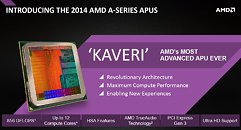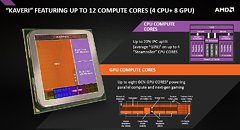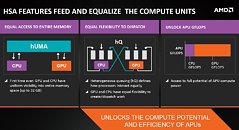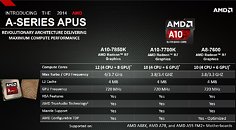- Joined
- Oct 9, 2007
- Messages
- 47,417 (7.51/day)
- Location
- Hyderabad, India
| System Name | RBMK-1000 |
|---|---|
| Processor | AMD Ryzen 7 5700G |
| Motherboard | ASUS ROG Strix B450-E Gaming |
| Cooling | DeepCool Gammax L240 V2 |
| Memory | 2x 8GB G.Skill Sniper X |
| Video Card(s) | Palit GeForce RTX 2080 SUPER GameRock |
| Storage | Western Digital Black NVMe 512GB |
| Display(s) | BenQ 1440p 60 Hz 27-inch |
| Case | Corsair Carbide 100R |
| Audio Device(s) | ASUS SupremeFX S1220A |
| Power Supply | Cooler Master MWE Gold 650W |
| Mouse | ASUS ROG Strix Impact |
| Keyboard | Gamdias Hermes E2 |
| Software | Windows 11 Pro |
AMD announced its 2014 A-Series APU for the desktop platform, code-named "Kaveri," after the southern-Indian river. Built in the new FM2+ package, the APUs run only on socket FM2+ motherboards based on the AMD A88X, A78, and A55 chipsets; while the socket itself can seat older FM2 APU families, "Trinity" and "Richland." In many ways, the socket transition is similar to that of socket AM3+. "Kaveri" sees AMD integrate two of its newest CPU and GPU micro-architectures, "Steamroller" for CPU, and Graphics CoreNext 2.0 for the GPU. "Kaveri" is also built on newer generation 28 nm silicon fab process.
"Steamroller" is an evolution of the same modular CPU core design as its predecessors, "Piledriver" and "Bulldozer." AMD promises a 10 percent improvement in performance clock-by-clock, per core, which falls in line with AMD's normal scheme of annual incremental performance updates on its CPU micro-architectures. A "Steamroller" module is a combination of two 64-bit x86 cores, which feature dedicated and shared components. "Kaveri" has two such modules, and so physically, it features a quad-core CPU.



The GPU inside A-Series "Kaveri" APUs is the fastest AMD ever crammed into a PC APU, although it doesn't come close to the APUs that drive Xbox One and PlayStation 4. Based on the Graphics CoreNext 2.0 micro-architecture, "Kaveri" features eight GCN compute units (CUs), which make up 512 stream processors, and 32 TMUs. The GPU supports DirectX 11.2, OpenGL 4.3, and Mantle. The GPU component also accelerates AMD's TrueAudio technology, which debuted with the Radeon R9 290 series. The GPU's display I/O lets you drive Ultra HD (3840 x 2160 pixels) displays with 60 Hz refresh rates, over DisplayPort 1.2. It supports up to four display outputs.
Moving on to the uncore portion of "Kaveri," AMD deployed a new-generation integrated memory controller (IMC). It supports up to 64 GB of dual-channel DDR3-2400 MHz memory. Its biggest feature id hUMA (heterogeneous unified memory access), which not only chucks out fixed memory partitions between the system and shared graphics memory area, but also makes the CPU and GPU access the same memory simultaneously. This should translate to greater system memory available to the OS (as "hardware reserved" GPU memory is eliminated), and better GPGPU performance. The second big highlight in the uncore department is the PCI-Express root complex, which now gives out up to 24 lanes of PCI-Express gen 3.0. This should translate into better CrossFire performance, in which a pair of graphics cards are given an 8-lane PCI-Express link, each.
AMD launched its 2014 A-Series APU family with three models, the A10-7850K, the A10-7700K, and the A8-7600. Specifications of the three parts are tabled below. The A10-7850K and A10-7700K will include Origin keys to Battlefield 4, and the two chips apparently meet the minimum system requirements of the game.

View at TechPowerUp Main Site
"Steamroller" is an evolution of the same modular CPU core design as its predecessors, "Piledriver" and "Bulldozer." AMD promises a 10 percent improvement in performance clock-by-clock, per core, which falls in line with AMD's normal scheme of annual incremental performance updates on its CPU micro-architectures. A "Steamroller" module is a combination of two 64-bit x86 cores, which feature dedicated and shared components. "Kaveri" has two such modules, and so physically, it features a quad-core CPU.



The GPU inside A-Series "Kaveri" APUs is the fastest AMD ever crammed into a PC APU, although it doesn't come close to the APUs that drive Xbox One and PlayStation 4. Based on the Graphics CoreNext 2.0 micro-architecture, "Kaveri" features eight GCN compute units (CUs), which make up 512 stream processors, and 32 TMUs. The GPU supports DirectX 11.2, OpenGL 4.3, and Mantle. The GPU component also accelerates AMD's TrueAudio technology, which debuted with the Radeon R9 290 series. The GPU's display I/O lets you drive Ultra HD (3840 x 2160 pixels) displays with 60 Hz refresh rates, over DisplayPort 1.2. It supports up to four display outputs.
Moving on to the uncore portion of "Kaveri," AMD deployed a new-generation integrated memory controller (IMC). It supports up to 64 GB of dual-channel DDR3-2400 MHz memory. Its biggest feature id hUMA (heterogeneous unified memory access), which not only chucks out fixed memory partitions between the system and shared graphics memory area, but also makes the CPU and GPU access the same memory simultaneously. This should translate to greater system memory available to the OS (as "hardware reserved" GPU memory is eliminated), and better GPGPU performance. The second big highlight in the uncore department is the PCI-Express root complex, which now gives out up to 24 lanes of PCI-Express gen 3.0. This should translate into better CrossFire performance, in which a pair of graphics cards are given an 8-lane PCI-Express link, each.
AMD launched its 2014 A-Series APU family with three models, the A10-7850K, the A10-7700K, and the A8-7600. Specifications of the three parts are tabled below. The A10-7850K and A10-7700K will include Origin keys to Battlefield 4, and the two chips apparently meet the minimum system requirements of the game.

View at TechPowerUp Main Site











